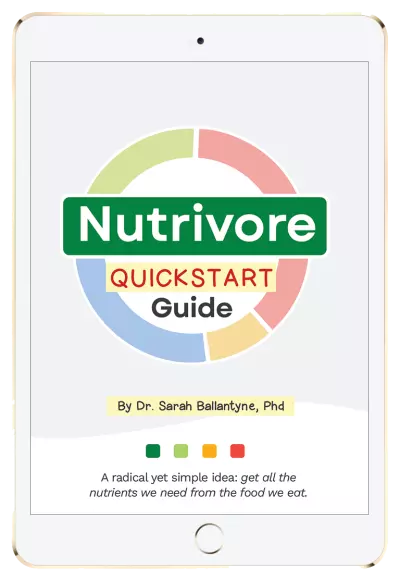Key Takeaways (expand)
- High diversity diets reduce risk of all-cause mortality, cardiovascular disease mortality and cancer mortality.
- While studies show that eating a wide variety of vegetables improves health outcomes, total dietary diversity is more important overall.
- More diverse diets are higher quality and more nutrient-dense, with a lower likelihood of problematic nutrient shortfalls.
- A good goal is to eat 12 different whole foods per day, and 35 different whole foods over the course of the week, with seasonal variation throughout the year.
One of the biggest nutritional challenges of the Standard American Diet is that, while it may feel like you’re eating a wide variety of foods, with so many being made from only a handful of ingredients (wheat, corn, soy, and dairy), the diet isn’t actually diverse. We can increase variety and nutrient density by replacing these types of foods (breads, cereals, pasta, pizza, crackers, cookies, etc.) with a diversity of whole foods instead.
Health Benefits of a Diverse Diet
Dietary diversity is typically defined as the total number of different food items in a diet. One way to measure dietary diversity this is Dietary Species Richness, the number of different species represented in the diet during a 1-year period. This is a technical way to classify foods for a measurement of dietary diversity, and you don’t need to sweat the confusing details here, but you can think of this as a methodical way of measuring the number of different whole foods represented in the diet. Strawberries count as one, blueberries count as one, salmon counts as one; but semolina and whole wheat pasta only count as one species since they’re both made of the same singular ingredient, the species Triticum turgidum, commonly called durum wheat!
Aim for 12 different whole foods per day, and 35 different whole foods over the course of the week.
In a 2021 study that included nearly half a million people living in nine European countries and followed for 22 years, the people in the highest quintile of Dietary Species Richness (81 or more different species in the diet over the course of a year) had a 37% reduced risk of all-cause mortality (a general indicator of health and longevity) than those in the lowest quintile of Dietary Species Richness (48 or fewer different species in the diet over the course of a year). The authors calculated that, for every additional 10 species we consume annually, all-cause mortality decreases by 10%!
While a variety of studies show benefits to eating a diversity of vegetables and fruit (including some discussed below, and see Importance of Vegetables and Fruit), it appears as though total dietary diversity is more important than diversity of any one food group. In this study, the authors further analyzed 10 different food groups (vegetables, tubers, legumes, fruit+nuts+seeds, dairy, cereals, meat, fish+shellfish, eggs and condiments) and showed that, while variety in veggies was slightly more important, there was no one food group that was substantially more important to mix it up than any other. Quite simply: the more different foods we eat, the healthier (on average) we’ll be!
Other studies have found similar results in other populations. For example, a 2019 study from Japan evaluated the impact of dietary diversity by measuring the average number of different foods in the diet in a single day. Comparing the highest quintile (34.9 or more different food items for men, and 39.8 or more different food items for women) to the lowest (13.4 of fewer different food items for men, and 15.4 or fewer different food items for women), high dietary diversity reduced risk of all-cause mortality by 19% in women. The 4% reduction in all-cause mortality in men was not statistically significant, although fruit diversity reduced all-cause mortality by 13% in men.
Another way that dietary diversity is measured is the Dietary Diversity Score, which reflects the number of different food groups represented in the diet over a 24 hours period. Exactly how food groups are defined for the Dietary Diversity Score is not standardized across studies; but for example, a 2022 study of a Mediterranean population awarded up to two points for different subgroups within fruits, vegetables, dairy products, cereals, and proteins, for a total score out of 10. Comparing the highest dietary diversity quartile (a Dietary Diversity Score higher than 6.1) to the lowest quartile (a Dietary Diversity Score less than 4.5), high dietary diversity reduced risk of all-cause mortality by 32% and reduced risk of cardiovascular disease mortality by 45%. This study also found that diversity of vegetables was important, with the highest quartile of vegetable diversity having 30% reduced risk of all-cause mortality and a 48% reduced risk of cardiovascular disease mortality than the lowest quartile.
And, a 2022 meta-analysis that included data from 20 longitudinal studies found that high dietary diversity reduced all-cause mortality risk by 22% compared to low dietary diversity, as well as reducing cardiovascular disease mortality by 17% and cancer mortality by 10%. Interestingly, this meta-analysis also showed that total dietary diversity was more important than any particular subgroup of food; vegetable diversity only accounted for a 5% reduced risk of all-cause mortality.
No matter how you measure dietary diversity, scientific studies show it’s a beneficial eating pattern to work on developing into a lifelong healthy habit.
Why Is Dietary Diversity Important?
Why is dietary diversity so effective at improving health outcomes? Quite simply, more diverse diets are higher quality and more nutrient-dense. For example, a study published way back in 1987 showed that consuming a greater variety of foods not only increases the overall nutrient profile of a diet but also helps prevent nutrient deficiencies. By including a wider range of whole foods, individuals naturally consume a more balanced distribution of essential vitamins, minerals, and phytonutrients. Furthermore, this study highlighted that dietary diversity positively correlates with better overall diet quality, as people who eat more diverse diets tend to include more nutrient-dense foods like vegetables, fruits, and lean proteins.
We also know that people are more likely to eat more vegetables and fruit if they eat a wider variety of them. For example, a 2018 study found that individuals who consistently consumed a diverse range of vegetables and fruits were more likely to meet their daily nutrient requirements, particularly for essential vitamins such as vitamin C, folate, and beta-carotene. The study also showed that increased variety within fruit and vegetable intake led to higher overall consumption, as greater selection encourages people to try new options, avoid taste fatigue, and incorporate different flavors and textures into their meals.
Furthermore, this dietary diversity was associated with improved long-term adherence to healthy eating patterns, reducing the likelihood of deficiencies and promoting better overall health outcomes. In fact, Dietary Diversity Scores can be used as a proxy for nutrition, with low scores equating to malnourishment and high scores equating to healthy diets. Essentially, a diversity of different foods equates to a diversity of nutrients, increasing the likelihood of getting all of the nutrients we need from our diets, i.e., Nutrivore!
Everything You Need to Jump into Nutrivore TODAY!

Nutrivore Quickstart Guide
The Nutrivore Quickstart Guide e-book explains why and how to eat a Nutrivore diet, introduces the Nutrivore Score, gives a comprehensive tour of the full range of essential and important nutrients!
Plus, you’ll find the Top 100 Nutrivore Score Foods, analysis of food groups, practical tips to increase the nutrient density of your diet, and look-up tables for the Nutrivore Score of over 700 foods.
Buy now for instant digital access.
Dietary Diversity Goals

All in all, these studies make a compelling case to eat as many different foods as possible. While more studies are needed to determine the best target number of different foods per day or per week, a case can be made to aim for 12 different whole foods per day, and 35 different whole foods over the course of the week, with seasonal variation throughout the year.
Remember though that every little bit counts, so a great goal is to simply mix it up in whatever way feels achievable to you right now. Maybe that’s just adding a single new vegetable or fruit to your rotation, or trying a new recipe once per week.
Tips for Diversifying Your Diet
If you’re looking for an practical tool to track your dietary diversity, check out the Nutrivore Weekly Serving Matrix. And, here are some practical tips to help increase dietary diversity and enjoy a broader range of foods and nutrients:
- Try One New Food Weekly: Challenge yourself to pick one new food each week, like a unique vegetable, grain, or spice. This helps you gradually expand your diet without feeling overwhelmed.
- Opt for Variety in Each Food Group: When choosing fruits, vegetables, grains, and proteins, try rotating options. Instead of always having spinach, for instance, try kale, chard, or arugula.
- Eat Seasonally: Focus on seasonal produce to naturally introduce new foods into your diet. This not only increases diversity but also gives you fresher, often tastier options.
- Mix Up Your Protein Sources: Rotate between animal and plant-based proteins, like chicken, fish, eggs, tofu, lentils, nuts, and seeds. This helps ensure you’re getting different amino acids, vitamins, and minerals.
- Experiment with Whole Grains: Instead of relying on rice or wheat, try quinoa, bulgur, farro, millet, and barley. Each grain brings unique nutrients to your plate.
- Create Colorful Meals: Aim for meals that include multiple colors, which often means a variety of fruits and vegetables. Each color group offers different antioxidants and phytonutrients.
- Use Herbs and Spices: Different herbs and spices don’t just add flavor but also bring unique health benefits. Try using fresh basil, mint, cilantro, turmeric, cumin, and ginger to mix things up.
- Switch Up Your Cooking Methods: Use a variety of cooking techniques—like roasting, steaming, grilling, and stir-frying—to bring out different flavors and textures in foods. This keeps meals interesting and helps you enjoy more foods.
- Build Balanced Bowls: Make “bowl” meals with a mix of grains, proteins, veggies, and healthy fats, adding different toppings and dressings. These make it easy to add variety in a single meal.
- Visit Local Markets: Check out farmers’ markets or specialty grocery stores to find unique, local, or international ingredients you might not find in regular supermarkets.
- Blend Multiple Veggies into Smoothies or Soups: For smoothies, combine greens like kale or spinach with fruits, and for soups, try blending a mix of root vegetables with spices. These are great ways to add more variety in a single dish.
- Rotate Snacks: Instead of always choosing the same snacks, try different fruits, veggies with dips, or nuts and seeds to broaden your intake.
- Eat Across Food Families: Try to include foods from a variety of “food families” each week, like cruciferous veggies, leafy greens, citrus fruits, berries, legumes, and nuts.
Increasing dietary diversity doesn’t have to be complicated. By mixing up choices, trying new foods, and using seasonal and local options, you’ll find it easy and enjoyable to add variety to your meals!
Citations
Expand to see all scientific references for this article.
Conrad Z, Thomson J, Jahns L. Prospective Analysis of Vegetable Amount and Variety on the Risk of All-Cause and Cause-Specific Mortality among US Adults, 1999⁻2011. Nutrients. 2018 Sep 27;10(10):1377. doi: 10.3390/nu10101377. PMID: 30261669; PMCID: PMC6213742.
Hanley-Cook GT, Huybrechts I, Biessy C, Remans R, Kennedy G, Deschasaux-Tanguy M, Murray KA, Touvier M, Skeie G, Kesse-Guyot E, Argaw A, Casagrande C, Nicolas G, Vineis P, Millett CJ, Weiderpass E, Ferrari P, Dahm CC, Bueno-de-Mesquita HB, Sandanger TM, Ibsen DB, Freisling H, Ramne S, Jannasch F, van der Schouw YT, Schulze MB, Tsilidis KK, Tjønneland A, Ardanaz E, Bodén S, Cirera L, Gargano G, Halkjær J, Jakszyn P, Johansson I, Katzke V, Masala G, Panico S, Rodriguez-Barranco M, Sacerdote C, Srour B, Tumino R, Riboli E, Gunter MJ, Jones AD, Lachat C. Food biodiversity and total and cause-specific mortality in 9 European countries: An analysis of a prospective cohrt study. PLoS Med. 2021 Oct 18;18(10):e1003834. doi: 10.1371/journal.pmed.1003834. PMID: 34662340; PMCID: PMC8559947.
Kobayashi M, Sasazuki S, Shimazu T, Sawada N, Yamaji T, Iwasaki M, Mizoue T, Tsugane S. Association of dietary diversity with total mortality and major causes of mortality in the Japanese population: JPHC study. Eur J Clin Nutr. 2020 Jan;74(1):54-66. doi: 10.1038/s41430-019-0416-y. Epub 2019 Mar 19. PMID: 30890778.
Krebs-Smith SM, Smiciklas-Wright H, Guthrie HA, Krebs-Smith J. The effects of variety in food choices on dietary quality. J Am Diet Assoc. 1987 Jul;87(7):897-903. PMID: 3598038.
McNaughton SA, Bates CJ, Mishra GD. Diet quality is associated with all-cause mortality in adults aged 65 years and older. J Nutr. 2012 Feb;142(2):320-5. doi: 10.3945/jn.111.148692. Epub 2011 Dec 21. PMID: 22190031; PMCID: PMC3593296.
Mozaffari H, Hosseini Z, Lafrenière J, Conklin AI. Is eating a mixed diet better for health and survival?: A systematic review and meta-analysis of longitudinal observational studies. Crit Rev Food Sci Nutr. 2021 May 27:1-17. doi: 10.1080/10408398.2021.1925630. Epub ahead of print. PMID: 34039222.
Rathnayake KM, Madushani P, Silva K. Use of dietary diversity score as a proxy indicator of nutrient adequacy of rural elderly people in Sri Lanka. BMC Res Notes. 2012 Aug 29;5:469. doi: 10.1186/1756-0500-5-469. PMID: 22931957; PMCID: PMC3470944.
Salehi-Abargouei A, Akbari F, Bellissimo N, Azadbakht L. Dietary diversity score and obesity: a systematic review and meta-analysis of observational studies. Eur J Clin Nutr. 2016 Jan;70(1):1-9. doi: 10.1038/ejcn.2015.118. Epub 2015 Jul 29. PMID: 26220567.
Tao L, Xie Z, Huang T. Dietary diversity and all-cause mortality among Chinese adults aged 65 or older: A community-based cohort study. Asia Pac J Clin Nutr. 2020;29(1):152-160. doi: 10.6133/apjcn.202003_29(1).0020. PMID: 32229454.
Tao L, Xie Z, Huang T. Dietary diversity and all-cause mortality among Chinese adults aged 65 or older: A community-based cohort study. Asia Pac J Clin Nutr. 2020;29(1):152-160. doi: 10.6133/apjcn.202003_29(1).0020. PMID: 32229454.
Torres-Collado L, García-de la Hera M, Cano-Ibañez N, Bueno-Cavanillas A, Vioque J. Association between Dietary Diversity and All-Cause Mortality: A Multivariable Model in a Mediterranean Population with 18 Years of Follow-Up. Nutrients. 2022 Apr 11;14(8):1583. doi: 10.3390/nu14081583. PMID: 35458145; PMCID: PMC9029508.
Zurbau A, Au-Yeung F, Blanco Mejia S, Khan TA, Vuksan V, Jovanovski E, Leiter LA, Kendall CWC, Jenkins DJA, Sievenpiper JL. Relation of Different Fruit and Vegetable Sources With Incident Cardiovascular Outcomes: A Systematic Review and Meta-Analysis of Prospective Cohort Studies. J Am Heart Assoc. 2020 Oct 20;9(19):e017728. doi: 10.1161/JAHA.120.017728. Epub 2020 Oct 1. PMID: 33000670; PMCID: PMC7792377.
Nutrivore Is a Game-Changer—This FREE Guide Shows You Why
Sign up for the free Nutrivore Newsletter, your weekly, science-backed guide to improving health through nutrient-rich foods — without dieting harder —and get the Beginner’s Guide to Nutrivore delivered straight to your inbox!



